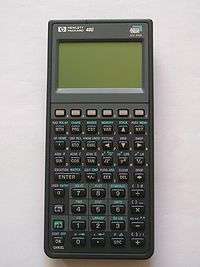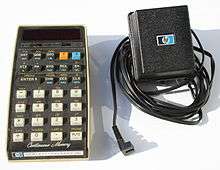HP calculators


HP calculators are various calculators manufactured by the Hewlett-Packard company over the years.
Their desktop models included the HP 9800 series, while their handheld models started with the HP-35. Their focus has been on high-end scientific, engineering and complex financial uses.
History
In the 1960s, Hewlett-Packard was becoming a diversified electronics company with product lines in electronic test equipment, scientific instrumentation, and medical electronics, and was just beginning its entry into computers. The corporation recognized two opportunities: it might be possible to automate the instrumentation that HP was producing, and HP's customer base were likely to buy a product that could replace the slide rules and adding machines that they were now using for computation.
With this in mind, HP built the HP 9100 desktop scientific calculator. This was a full-featured calculator that included not only standard "adding machine" functions but also powerful capabilities to handle floating-point numbers, trigonometric functions, logarithms, exponentiation, and square roots.
This new calculator was well received by the customer base, but William Hewlett saw additional opportunities if the desktop calculator could be made small enough to fit into his shirt pocket. He charged his engineers with this exact goal using the size of his shirt pocket as a guide. The result was the HP-35 calculator. This calculator provided functionality that was revolutionary for a pocket calculator at that time.
Through the years, HP released several calculators that varied in their mathematical capabilities, programmability, and I/O capabilities. Some of them could be used (via HP-IL) to control the instruments other Hewlett Packard divisions produced.
Characteristics
HP calculators are well known for their use of Reverse Polish Notation (RPN).
Programmable HP calculators allow users to create their own programs.
Calculators
Below are some of HP’s handheld calculator models produced over the years, in numeric rather than chronological order:
- HP 9g — Graphing calculator designed by Kinpo Electronics, Inc.
- HP 9S — Scientific calculator designed by Kinpo Electronics, Inc., with the same form factor as the 9G and the 30S
- HP-10 — 1977 basic 4 function calculator with printer and conventional arithmetic entry (no RPN).
- HP-10B - Financial calculator introduced in 1988.
- HP-10C — 1982–1984. Range entry calculator, Scientific Programmable, statistical functions.
- HP-11C — Scientific Programmable, including hyperbolics, gamma function, statistical functions, and random number generation.
- HP-10s — A scientific calculator with more 240 built-in functions, with 2 lines x 10 digits LCD.
- HP-12C — The finance-centric programmable calculator from the HP-10 series introduced in the 1980s. The longest running product in the HP calculator line, it remains in production.
- HP-15C — Advanced Scientific Programmable, including hyperbolics, gamma function, combinatorial and statistical functions, random number generation, numerical integration, numerical root finding, plus comprehensive matrix operations and full support for complex numbers.
- HP-16C — Computer science programmable calculator that could perform binary arithmetic, base-conversion (decimal, and binary, octal, and hexadecimal) and boolean-logic functions.
- HP-17B — Financial calculator superseding the 12C, with two-line display, alphanumerics and sophisticated Solve functions rather than step programming. Uses the Saturn chip set.
- HP-18C — A 1986 RPL clamshell business calculator.
- HP-19B — Financial calculator.
- HP-19C — 1977 calculator with RPN and built-in thermal printer. Included a programming language with looping and branching.
- HP 20b — 2008 financial calculator with RPN.
- HP-20S — A basic scientific calculator, using infix notation, barely programmable and with no graphing capabilities.
- HP-21 — Scaled-down HP-25.
- HP-25 — Smaller programmable model with programs up to 49 steps. Version HP-25C was first calculator with "continuous memory".
- HP-27S — The first HP calculator to use algebraic notation only rather than RPN. A 1988 scientific calculator, it was a "do all" calculator that included algebraic solver like the HP-18C, statistical, probability and time/value of money calculations.It had approximately 7 kilobytes of programmable memory which could be used for formulas or notes. The two-push 6-key letter typing system was fairly fast after a learning period.[1]
- HP-28C — (1987) RPN scientific graphing calculator. First graphing calculator, and introduced the Forth-like RPL, programmable keys, and symbolic equation solving, with 2 kB of user memory. Book-style design (flip-open cover) with keys on both interior halves. Intended for programs to be entered, used, and then deleted.
- HP-28S — (1988) Expansion of HP-28C; 32 kB of user memory due to customers unexpectedly keeping programs in memory for extended periods. Introduced a file system for storing variables, functions, and user programs in the form of a multi-level tree (similar to Unix filesystems). Like the HP-28C, this model used the "open-book" physical design. Functionally a direct predecessor to the HP-48 series, which returned to a more traditional physical design based on the HP-41.
- HP-29C — 1977 Programmable calculator with RPN. Included a programming language with looping and branching. An inexpensive variation on the 19C printer.
- HP 30b - Programmable Financial calculator released in 2010. Built in Black-Scholes Equation, FMRR and MIRR. Powered by ARM processor. Multiple input methods including RPN, Chain algebraic, and normal.
- HP 30s — Calculator designed by Kinpo Electronics, Inc.
- HP-32S — Scientific programmable, updated to HP-32SII
- HP 33s — Calculator designed by Kinpo Electronics, Inc.
- HP-33C — Scientific Programmable—successor to the HP25 and HP25C.
- HP-34C — Scientific Programmable calculator. First with integration and Root Finding.
- HP-35 — HP's first pocket calculator, and the world's first pocket calculator with transcendental functions. As such, it is regarded as the first "scientific" calculator.
- HP 35s — Introduced to commemorate the 35th anniversary of the HP-35, it is an advanced scientific programmable calculator, featuring algebraic and RPN modes, hyperbolics, statistics, numerical integration, numerical solver, random number generation, equations, and full programmability, using up to 32 Kb of RAM for programs and data.
- HP-38G — a simplified graphic model, using infix notation.
- HP-39g series — A successor to the HP-38, using infix notation.
- HP-39gII — Released in 2012.
- HP-40 series — A successor to the HP-38, using infix notation.
- HP-41 series — Three models in this series were released over its lifetime, the 41C, 41CV, and 41CX. The 41C had user configurable program steps and memory registers, alpha-numeric display, user programmable key mappings, and four expansion ports that could hold additional memory, an interface to HP-IL peripherals, a magnetic card reader–writer, or commercial application programs. The 41CV quintupled the amount of base memory, and the 41CX added a clock and some additional functions and memory.
- HP-42S — a non-expandable follow-up to the HP-41 series. It included a two line display (dot addressable) and featured built-in matrix and complex number mathematics.
- HP-45 — Improved version of the HP-35 with 10 memory registers, extra functions and display format selection.
- HP-48 series — Programmable scientific(S), then later graphic(G) model calculators, SX and GX versions had expansion slot. Based on the functionality of the HP-28S, but with a return to a traditional appearance (similar to the HP-41 series). Historically one of the most popular models among engineers. Uses a filesystem first introduced on the HP-28S. Has a real-time clock and an operating system with programmable-action alarms, which could turn on the calculator and run arbitrary user programs at a user-specified time & frequency.
- HP-49 series — Enhanced, graphic versions of the HP-48 series. Later models designed by Kinpo Electronics, Inc.
- HP-50g — As of 2007, the latest member of the HP-49 series. Faster (ARM processor), larger display, and ability to read/write removable SD memory cards.
- HP-55 - Lower cost version of the HP-65; no magnetic card reader, only 49 programming steps, but had 20 registers instead of just nine. Only model with an accurate (quartz crystal) stopwatch mode.
- HP-65 — First programmable pocket calculator. Programs could be up to 100 steps in length and could be written to or read from magnetic strips.
- HP-67 and HP-97 — Improved version of the HP-65, HP-97 is a desktop version.
- HP-71B — Handheld model natively programmable in an extended BASIC language including a RAM-based filesystem, recursion, multiline user-defined functions and subprogram calling with parameter passing, but also capable of accepting plug-in ROM modules to provide such functionalities as full I/O capabilities to any type of device (printers, mass storage, measurement instruments), programmability in other languages (Forth, Assembler), advanced math capabilities (such as matrix operations, support for complex numbers, multidimensional numerical integration and root finding, Fast Fourier Transforms, etc.), and an advanced Calculator Mode capable of executing algebraic expressions one step at a time and undoing individual steps.
- HP-80 - HP's second handheld calculator, designed for business and including functions for Time Value Of Money and similar.[2]
- HP Prime—Fall 2013 release of a "smart phone competitor" with 3.5" color touch screen, "apps," 50g CAS and a unique exam feature that allows both selection of RPN vs. Algebraic vs. textbook AND exam format for use on the SAT. Includes several new features such as color graphing animation and wireless (dongle) connectivity. Specifications at .
References
- ↑ http://calculator/museum.org/hp27s.htm
- ↑ HP-80, The Museum of HP Calculators
External links
- HPMuseum.org Museum of slide rules and significant HP calculators
- HPCalc.org Information about and software for HP programmable calculators
- MyCalcDB HP calculators list.
- Calc Pages Articles and programs for classic HP calculators
- Programmable Calculators Pictures, specifications, and details for most HP calculator
- The HPDATAbase, a collection of data about all HP calculators
Simulators
- HP12C Simulator Web based
- HP15C Simulator for Windows (XP and following), Mac OS X (Intel) and Linux (x86)
- HP25C Simulator for Windows NT/2K/XP and Vista (32 bit only)
- HP29C Simulator for Windows NT/2K/XP and Vista (32 bit only)
- HP33C Simulator for Windows NT/2K/XP and Vista (32 bit only)
- HP67 Simulator for Windows NT/2K/XP and Vista (32 bit only)
- HP97 Simulator for Windows XP and Vista (32 bit only)
- Nonpareil free source HP simulator set for Linux, Mac OS X and Windows
- nonpareil for Mac OS X
- debug4x ?
- x49gp for Unix machines
- HP emulators for the PC
- HP page of Christoph Giesselink
- emu48 emulator quick setup
- The RPN/RPL Implementations list includes many simulators
- HP Calculator emulators, 12c, 15c, 42s, 48GX, etc. for iPhone and iPad (by various developers)